

Young. Sources of the Self: The Making of the Modern Identity - Charles Taylor. The American T. S. Eliot: A Study of the Early Writings - Eric Sigg. He Do the Police in Different Voices: Eliot, Voices, and Drama. The Waste Land confronts its reader with a multitude of voices—calm voices and agitated voices; formal voices and colloquial voices; voices speaking in German, in French, in Italian, Latin, Greek, even Sanskrit; voices with different accents; the voices of works of art both high and low.
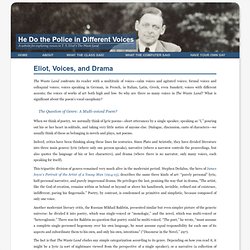
So why are there so many voices in The Waste Land? What is significant about the poem's vocal cacophony? The Question of Genre: A Multi-voiced Poem? When we think of poetry, we normally think of lyric poems—short utterances by a single speaker, speaking as “I,” pouring out his or her heart in solitude, and taking very little notice of anyone else.
Dialogue, discussion, casts of characters—we usually think of these as belonging in novels and plays, not poems. Indeed, critics have been thinking along these lines for centuries. This tripartite division of genres remained very much alive in the modernist period. The fact is that The Waste Land eludes any simple categorization according to its genre. . — . — . —. Walter Benjamin. Terry Eagleton: Quotations. Harold Bloom. (1) 'Fictions of the City' reviewed by Richard Hornsey. Emulate the model of the country estate.
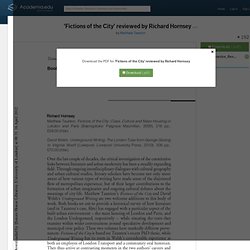
A general lack of effective plan-ning regulations, coupled with the city’s highly developed transportsystem, set the conditions for great rings of owner-occupied housing tobe erected by private builders at an ever-greater radius from the metropo-litan centre. Thetwocities, insum, were fashioned bya precisely inversesetof centripetal and centrifugal forces, which produced wildly divergent resi-dential landscapes and domestic experiences of class.Taunton goes on to chart not only how these different forms of masshousing became associated in fiction with specific structures of experience,but also the ways in which these representations fed into ongoing local andnational debates around public policy and the planned provision of homes. At its most insightful, his book reveals how his principal characters – the locataire.
Dante and Aesthetics in The Waste Land. The text of "The Romantic Englishman ..." by T.S. Eliot. T.S. Eliot Introduction. The Modern Language Review, Vol. 74, No. 2 (Apr., 1979), pp. 281-286. The Waste Land Research Papers discuss a poem after World War I. Poetic Licence – Iain M. Banks’ Consider Phlebas and T.S. Eliot’s The Waste Land. I wrote this some time ago, but I’m reposting it to celebrate 25 years of Iain Banks’ The Culture: Gentile or Jew O you who turn the wheel and look to windward, Consider Phlebas, who was once handsome and tall as you.
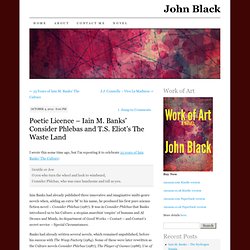
Iain Banks had already published three innovative and imaginative multi-genre novels when, adding an extra ‘M’ to his name, he produced his first pure science fiction novel – Consider Phlebas (1987). It was in Consider Phlebas that Banks introduced us to his Culture: a utopian anarchist ‘empire’ of humans and AI Drones and Minds, its department of Good Works – Contact – and Contact’s secret service – Special Circumstances. Banks had already written several novels, which remained unpublished, before his success with The Wasp Factory (1984). The Waste Land. The Origin of the Work of Art. The Origin of the Work of Art (German: Der Ursprung des Kunstwerkes) is an essay by the German philosopher Martin Heidegger.
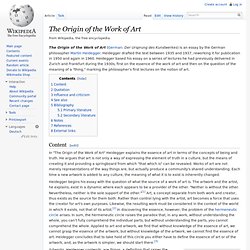
Heideggerworkofart. The Wasteland and the Hero - College Essay - Beckster471. The Wasteland, based on the texts I have read, is a varied and diverse environment of barrenness and death.
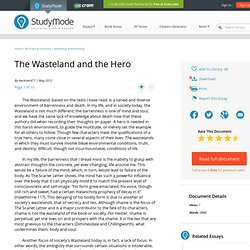
In my life, and in society today, the Wasteland is not much different; the barrenness is one of mind and soul, and we have the same lack of knowledge about death now that these authors did when recording their thoughts on paper. A hero is needed in this harsh environment, to guide the multitude, or merely set the example for all others to follow. Though few characters meet the qualifications of a true hero, many come close in several aspects of their lives. Tradition and The Waste Land. This site is owned and maintained by William Ames, a member of the Modern Language Association.
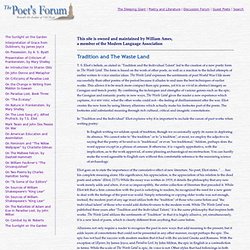
Tradition and the Individual Talent. T.S. Eliot. 1921. The Sacred Wood; Essays on Poetry and Criticism. Philip Massinger. T.S. Eliot. 1921. The Sacred Wood; Essays on Poetry and Criticism. T. S. Eliot: Quotes, Life, Poetry, Plays, Literary Criticism, Critical Reception, Works, Further Reading, and a List of Books by Author T. S. Eliot. For a poet of his stature, Eliot produced a relatively small amount of poetry.

He was aware of this early in his career. He wrote to J. H. Woods, one of his former Harvard professors, that, "My reputation in London is built upon one small volume of verse, and is kept up by printing two or three more poems in a year. The only thing that matters is that these should be perfect in their kind, so that each should be an event. " Typically, Eliot first published his poems individually in periodicals or in small books or pamphlets, and then collected them in books.
On The Waste Land. The Burial of the Dead. Notes on "The Burial of the Dead.